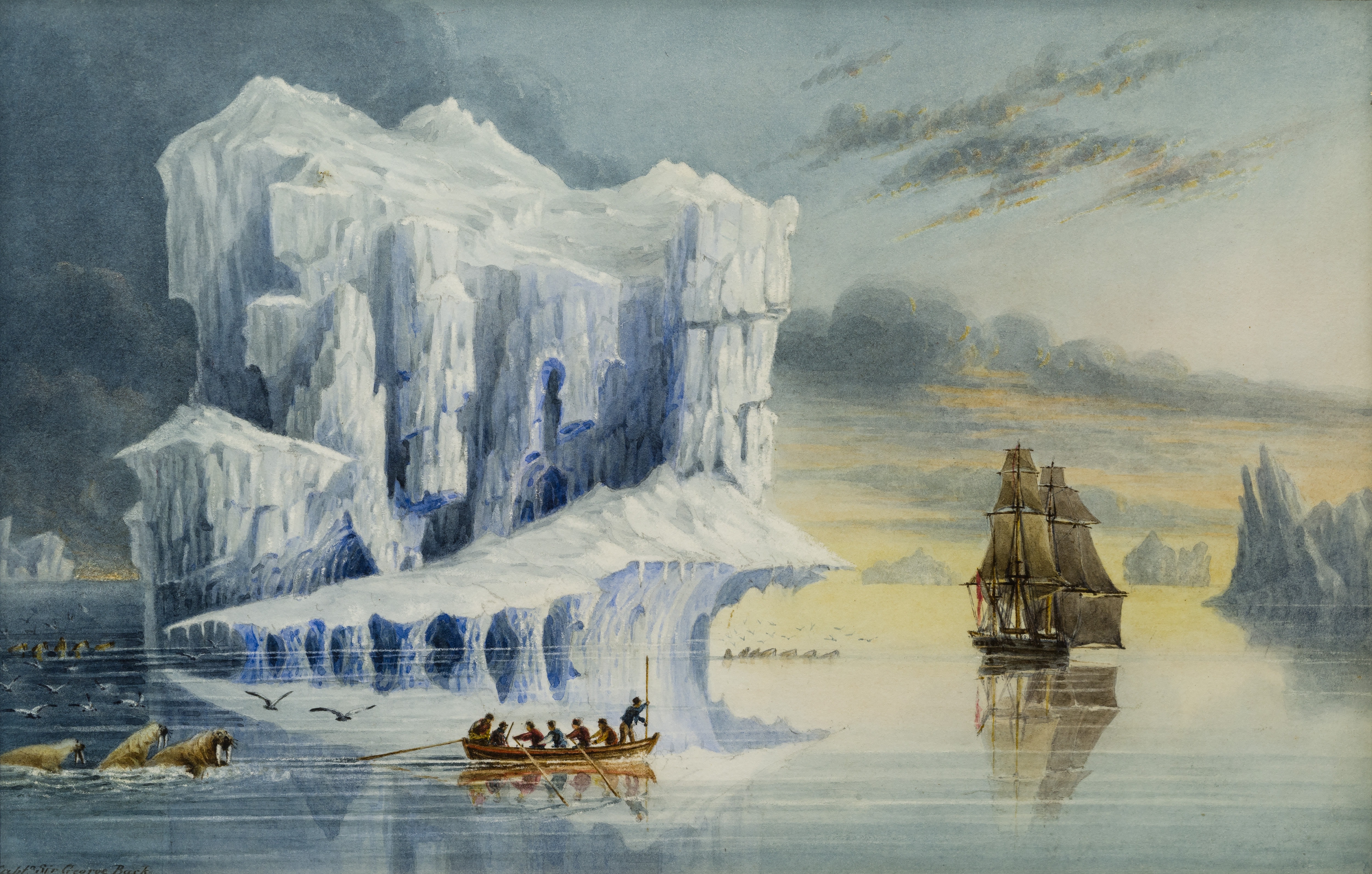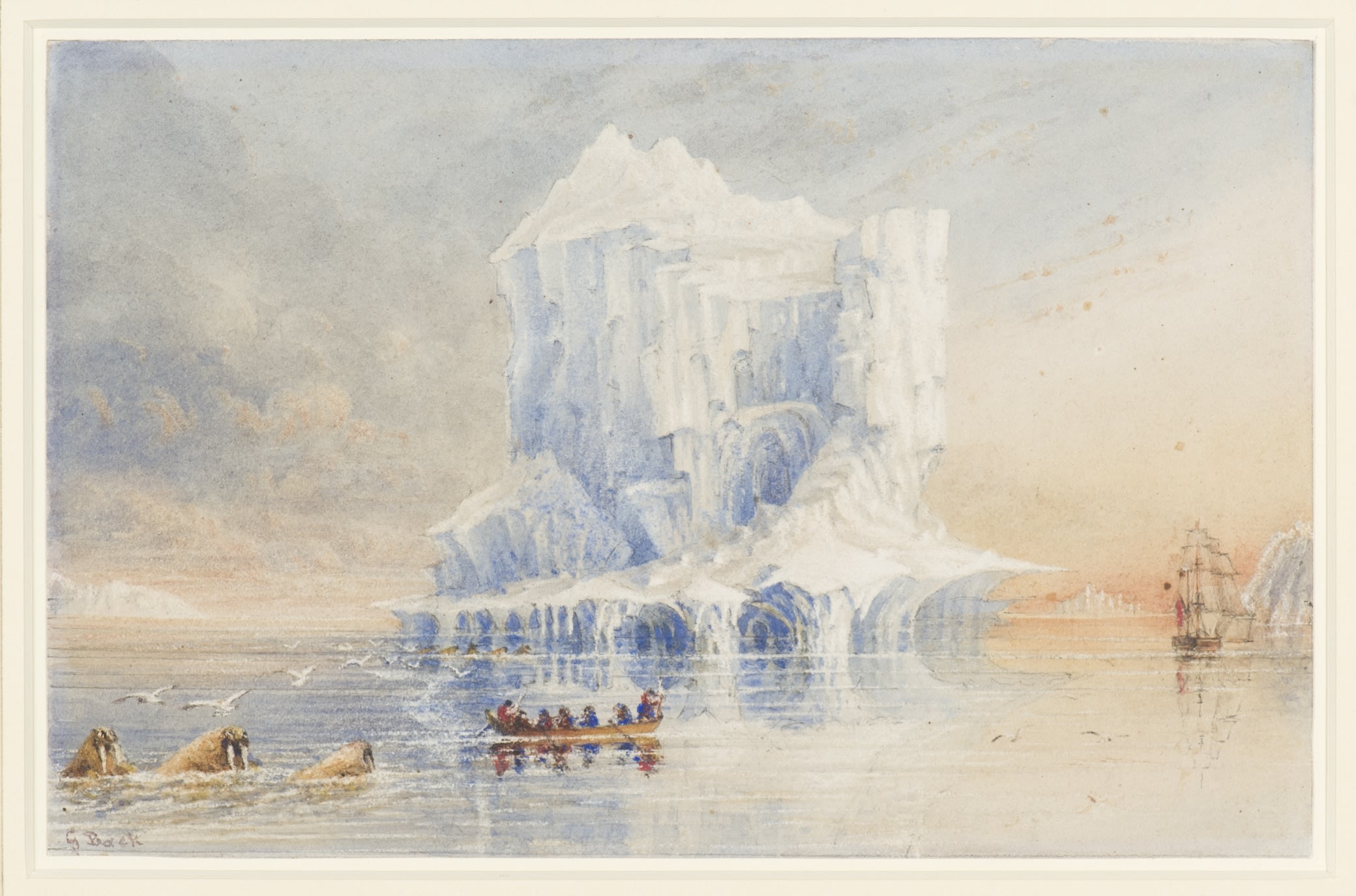Sold | A Rare 19th Century Watercolour from the Era of Arctic Exploration

Sir George Back. Icebergs at the Entrance of Hudson's Strait, with M.S. Discovery Ship Terror, 1836 (August), Watercolour, 7 1/8 x 10 7/8 (18.1 x 27.6 cm). SOLD.
George Back was one of the most prominent European arctic explorers, alongside the likes of Sir John Franklin, William Parry, John and James Ross, and Roald Amundsen. Back’s expeditions overcame severe hardships and near catastrophe to advance the mapping of North America’s Arctic coastline, a legacy he chronicled in his narratives and artworks.
When it acquired a similar watercolour in 2011, the Canadian Museum of Civilization (today the Canadian Museum of History) published a statement which read:
“Few vessels have played so important a role in Canadian history as HMS Terror. Its first Arctic expedition in 1836–1837, commanded by Sir George Back, was beset with difficulties: trapped in ice for 10 months, the Terror was at one point pushed by ice more than 12 metres up the side of a cliff. By the time the badly damaged ship returned to Britain, it was close to sinking.” [1]

That watercolour, and the present one, Icebergs at the Entrance of Hudson's Strait, with M.S. Discovery Ship Terror, convey a scene from Back’s 1836-37 expedition to find the Northwest Passage. In addition to its historical significance, it evidences Back as an accomplished artist.
In his, Narrative of an Expedition in H.M.S. Terror, Back recorded the expedition in fabulous and sometimes gripping detail. In an entry dated July 29th, 1836, the day before Terror sighted the Labrador coast, he wrote:
“Accordingly in the evening when the weather cleared, we observed an enormous berg, the perpendicular face of which was not less than 300 feet high, and other smaller bergs, nine altogether, in other directions.” [2]
The present watercolour is believed to illustrate this encounter, and Back created several versions of the composition in watercolour and pencil.
The expedition was a harrowing one that nearly ended in disaster. On June 11th, 1836, then-Captain Back received orders from the Commander of the Royal Navy at Sheerness, England:
His Majesty's Government having been pleased to command that another attempt by the way of Wager River should be made to trace the northern boundary of the North American Continent : We have thought fit to appoint you to the command of that expedition, and you are hereby required and directed to put to sea in His Majesty's ship Terror, under your command, the moment that she is in all respects ready, and to proceed with the utmost celerity in the execution of the following Instructions...
On June 14th, HMS Terror sailed up the River Medway from its anchorage in Chatham.
Unfortunately, conditions were unfavourable that year, and by late summer Terror had become trapped in ice near Southampton Island, at the entrance to Hudson Bay. She drifted with the ice for ten months and was finally released in July of 1837. By that point Terror was so badly damaged that the expedition had to be abandoned. She limped back across the North Atlantic and was beached in a sinking condition in Lough Swilly, Ireland on September 3rd. She was eventually repaired and returned to service.
Eight years later, Terror became part of one of the great maritime mysteries when she disappeared during the Franklin Expedition (1845-1848), along with her sister ship HMS Erebus, and the entire expedition crew. The mystery captivated the public for more than 175 years, and while the wreck of Terror was finally discovered in 2016, the gruesome final days of the crew are still left to haunt the imagination. Those final days, incidentally, were not without reference to George Back.
In 1859, more than 12 years after it set sail, the last communication from the Franklin Expedition was discovered in a cairn on King William Island. Dubbed the Victory Point Note, and dated April 25th, 1848, it reported that Terror and Erebus had been abandoned on April 22nd after being stranded for two winters, and that the surviving crew were beginning an overland journey to a Hudson Bay Company outpost near Backs Fish River (today Back River), named for George Back. None of the 105 crew who began the trek made it to the outpost.
Footnotes:
[1] Lynch, P. (2012, January 3). A PRECIOUS PAINTING RESURFACES AT THE CANADIAN MUSEUM OF CIVILIZATION. Canadian Museum of History. https://www.historymuseum.ca/media/a-precious-painting-resurfaces-at-the-canadian-museum-of-civilization/
[2] Back, G. (1837). Narrative of an Expedition In H.M.S Terror, Undertaken With A View To Geographical Discovery On The Arctic Shores, In The Years 1836-7 (pp. 26-27). London: John Murray, Albemarle Street. https://archive.org/details/narrativeofexped00back/page/26/mode/2up?ref=ol&view=theater




Add a comment